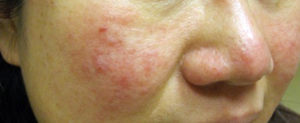What is Rosacea?
April has been selected by the National Rosacea Society as Rosacea Awareness Month, a time to inform and educate the public on this chronic skin disorder.
Rosacea is a skin condition that mainly appears on the face. It affects an estimated 14 million Americans of all races and ages, though primarily is found in adults between the ages of 30 – 50. Both men and women can have the condition, but men tend to have cases that are more severe than women.
Signs & Symptoms
According to the American Academy of Dermatology, rosacea often begins with a tendency to blush or flush more easily than other people. If you notice one or more of the following issues on your face, contact a dermatologist to find out if you have rosacea.
- Persistent redness
- Skin thickening
- Flushing
- Bumps & pimples
- Visible blood vessels
- Eye irritation
Types of Rosacea
Since many symptoms characterize the condition, rosacea is divided into four subcategories. People can have more than one subtype.
- Subtype 1: Facial redness, flushing, visible blood vessels (Erythematotelangiectatic rosacea)
- Subtype 2: Acne-like breakouts (Papulopustular rosacea)
- Subtype 3: Thickening skin (Phymatous rosacea)
- Subtype 4: Affecting the eyes (Ocular rosacea)
Causes of Rosacea
Although research into rosacea has made some discoveries that can help people manage the condition, the exact cause of rosacea is unknown. Some possible contributors to rosacea that researchers are looking into are indicated below.
- Hereditary connection
- Immune system reaction
- Bacteria called H. pylori
- Mite on the skin called Demodex
- Body’s ability to process a protein called cathelicidin
In any case, professionals recommend that persons affected keep a diary of daily activities to become aware of what triggers flare-ups. Triggers are different for each person. Knowing your triggers will help a dermatologist to develop a specific treatment plan. Some common triggers are listed below.
- Sunlight
- Stress
- Heat
- Alcohol
- Spicy foods
- Some skin and hair products
- Some makeup
- Wind and cold
- Some medicines
- Exercise
Skin Management for Rosacea
Know Your Triggers
If you have rosacea, you want to get a handle on what causes your skin to flare up. Then modify your behavior based on this knowledge by avoiding or minimizing those scenarios.
Sun Protection
Always protect your skin by wearing a rosacea-friendly sunscreen every day and protective clothing, like a hat.
Skincare Routine
You must also take care to use mild skincare products on your skin. Do not rub or scrub the skin in an abrasive manner. Avoid physical exfoliators and strong astringents, as these can make rosacea flare.
Treatments
Depending on the type of rosacea you have, the treatment method will vary.
- Use a green-tinted makeup – This can be used to hide the redness of your skin.
- Laser & light-based therapy – This can be very effective for clearing redness and visible blood vessels in the skin, as well as reducing acne-like breakouts. Intense Pulsed Light (IPL), BBL and Pulse Dye laser (PDL, V Beam) have all been used effectively.
- Topical creams – Can be used to reduce redness or for acne-like breakouts. Topical preparations that contain metronidzole, azaleic acid, ivermectin, and sodium sulfacetamide are effective.
- A warm compress or gentle eye cleanser – This is for rosacea that affects the eyes.
- Antibiotics – Can reduce redness and acne-like breakouts.
- Surgery – If a patient’s skin becomes severely thickened on the nose, surgery may be needed to remove the excess tissue.
- Botox – This is a more recent treatment that is showing promise in reducing redness.
Even though a cure is not yet available for rosacea, with the help of a dermatologist, you can develop a plan to manage it. Knowing your triggers and making some lifestyle changes can go a long way in helping you to control the condition successfully. For more information or to schedule an appointment, contact me today to begin on the road to feeling and looking your best.
Previous Post Next Post